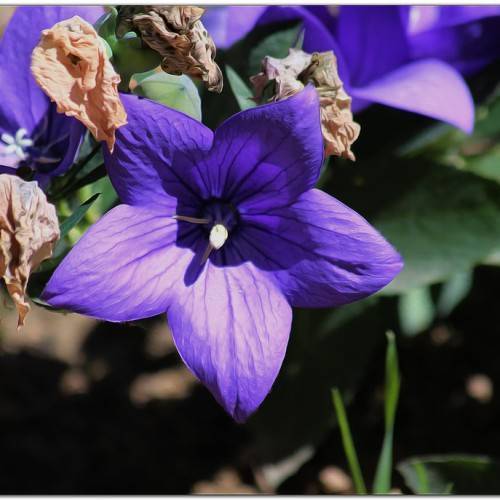
balloon flower
Platycodon grandiflorus
Cycle:
Herbaceous Perennial
Watering:
Average
Hardiness Zone:
3 - 8
Flowers:
Flowers
Sun:
Full sun,part shade
Leaf:
Yes
Growth Rate:
Low
Maintenance:
Low
Drought Tolerant:
Yes
Care Level:
Medium
watering
Balloon flowers should be watered thoroughly and regularly throughout the summer growing season. The best way to water a balloon flower is to soak the soil deeply and slowly once every week. In hot, dry weather, water more frequently. For example, if the weather is dry and unusually hot, water 2 to 3 times per week. For optimal growth and flowering, avoid allowing the soil to dry out completely. In winter, the plant requires less watering, but it still needs to stay moist. Aim to water about once every 10 days to 2 weeks during the winter months.
sunlight
Balloon flowers (Platycodon grandiflorus) require full sun to partial shade for optimal growth. In full sun, balloon flowers should get at least 6 hours of sunlight each day. In partial shade, the plants can get 4-6 hours of sunlight a day. When grown in partial shade, the plants may not produce as many flowers as those grown in full sun. During peak summer months, when temperatures may get very high, it is best to provide some afternoon shade for balloon flowers to avoid sunburn and withering of the leaves.
pruning
Balloon flower (Platycodon grandiflorus) should be pruned lightly at the beginning of the growing season in the springtime. To lightly prune, trim off the old flower heads and spent foliage. You can also remove dead, discolored, or broken branches during this time. Cut as close to the branch or above a healthy bud. Leave any healthy branches alone to help the plant stay strong and develop more flowers. Pruning again during the summer is not advisable since it may slow the growth of the plant. You can lightly trim the foliage in by late summer to promote new flowering branches.
FAQ
Is it easy to propagate balloon flowers from seeds?
Propagating balloon flowers from seeds is possible but it is not particularly easy. Because the seeds are rather small compared to the size of the flower, it can be hard to collect, sow, and properly cultivate them. Additionally, the seed does not experience a long shelf life, so it is important to sow them immediately after collection. The seeds also have a long germination time which can be a tricky process, and even then, balloon flowers may take up to 2 to 3 years to start blooming once planted.
Is it possible to grow balloon flowers indoors?
Yes, it is possible to grow balloon flowers indoors. Balloon flowers (Platycodon grandiflorus) are herbaceous perennials that can survive in a wide range of temperatures and light conditions, making them suitable for indoor cultivation. While best grown outdoors in zones 4 to 9, they can be grown in bright, indirect light indoors, usually near a south-facing window. Planting the flower in a small pot with well-draining potting soil and watering regularly (but not too often) will help the balloon flower thrive indoors.
Should I remove the faded flowers of balloon flowers?
Yes, you should remove the faded flowers of balloon flowers. Removing the faded flowers encourages the plant to produce more flowers, extends the blooming season, and helps to keep the plant healthy. If you are growing balloon flowers as a cut flower, you may want to consider removing the faded flowers as it may help to extend the season of the flower’s beauty. Additionally, removing faded flowers can help to prevent the spread of disease or pests.
Could balloon flowers survive in a cold climate?
Balloon flowers can survive in a cold climate, but they may not last as robustly as they would in a warmer climate. While they don't require a lot of care, they may need a little extra attention in a cold climate - like protecting them from the cold winter winds with burlap or lightweight row covers. They prefer a light soil, so adding mulch to their environment can also help them stay warm and happy in colder climates.
Is it possible to grow balloon flowers from cuttings?
Yes, it is possible to grow balloon flowers from cuttings. To do so, take a few cuttings from a healthy, mature plant and remove any leaves from the lower half of the cutting. Dip the cut end of the cutting into a rooting hormone and then insert it into a container filled with moist potting soil. Cover the container with plastic and keep it warm and moist. With a little bit of luck, the cutting will root in about six weeks and you can then transplant the newly rooted cuttings in their own containers.
Are balloon flowers annuals or perennials?
Balloon flowers (Platycodon grandiflorus) are perennials, meaning that they live for more than one growing season. They are hardy in U.S. Department of Agriculture plant hardiness zones 4 through 8. They are native to China and Japan and are part of the campanulaceae family.
Should I mulch around balloon flowers?
Yes, mulching around balloon flowers is a great way to keep the soil moist and provide additional nutrition. Mulch also helps keep weeds away and can help reduce disease problems. It will also help prevent the plant from drying out, especially in hot weather. Make sure to use organic mulches such as grass clippings or compost, and keep the mulch away from the crown of the plant.
Could balloon flowers be used in a rock garden?
Yes, balloon flowers can be used in a rock garden. These flowers are known for their rosette shaped foliage and star-shaped pink or blue flowers that make them perfect for rock gardens and other harsh growing environments. Plant them in clusters in sunny areas with good drainage to enjoy their blooming beauty, year after year. Low maintenance and drought tolerant, balloon flowers are perfect for bringing color and texture to your rock garden landscape.
